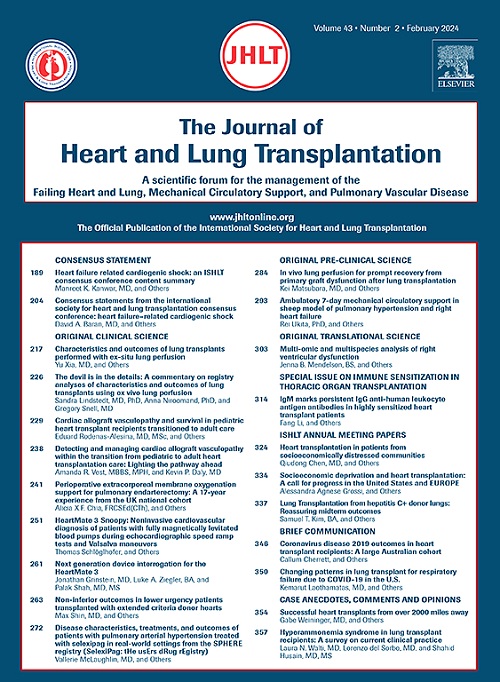Multi-institutional outcomes of Impella use in pediatric patients: A brief communication from the ACTION Network
IF 6
1区 医学
Q1 CARDIAC & CARDIOVASCULAR SYSTEMS
引用次数: 0
Abstract
This retrospective cohort study includes 150 pediatric patients supported with the Impella between April 2018 and November 2024. Median weight was 62.9 kg (interquartile range [IQR] 51.0-79.7 kg) and the smallest weighed 19.0 kg. Axillary artery implants occurred in 40.1% of patients while the femoral artery was used in 29%. Most patients had dilated cardiomyopathy (57.3%); however, a significant portion had transplant graft dysfunction (14.7%) or congenital heart disease (13.3%). One quarter of the cohort (N = 38) were supported with extracorporeal membrane oxygenation (ECMO) before Impella; 76% (N = 29) used ECMO and Impella in tandem, while 24% (N = 9) transitioned from ECMO to Impella. Major bleeding, major infection, device malfunction, or stroke were reported in 28% of patients (N = 42). Positive clinical outcomes were achieved in 89.3% of patients; 32.7% explanted for recovery, 32% transplanted, and 23.3% changed to another device. These data demonstrate a potential role for this device in children with refractory advanced heart failure and a need for increased work to limit adverse events.
儿科患者使用Impella的多机构结果:来自ACTION网络的简短交流。
这项回顾性队列研究包括150名在2018年4月至2024年11月期间接受Impella支持的儿科患者。中位体重为62.9kg (IQR 51.0-79.7kg),最小体重为19.0kg。腋窝动脉植入占40.1%,股动脉植入占29%。大多数患者有扩张型心肌病(57.3%),但也有相当一部分患者有移植物功能障碍(14.7%)或先天性心脏病(13.3%)。四分之一的队列(N=38)在Impella之前接受了ECMO支持;76% (N=29)同时使用ECMO和Impella, 24% (N=9)从ECMO过渡到Impella。28%的患者报告大出血、严重感染、器械故障或中风(N=42)。89.3%的患者获得了积极的临床结果;32.7%为外植恢复,32%为移植,23.3%更换其他装置。这些数据证明了该装置在难治性晚期心力衰竭儿童中的潜在作用,需要增加工作以限制不良事件。
本文章由计算机程序翻译,如有差异,请以英文原文为准。
求助全文
约1分钟内获得全文
求助全文
来源期刊
CiteScore
10.10
自引率
6.70%
发文量
1667
审稿时长
69 days
期刊介绍:
The Journal of Heart and Lung Transplantation, the official publication of the International Society for Heart and Lung Transplantation, brings readers essential scholarly and timely information in the field of cardio-pulmonary transplantation, mechanical and biological support of the failing heart, advanced lung disease (including pulmonary vascular disease) and cell replacement therapy. Importantly, the journal also serves as a medium of communication of pre-clinical sciences in all these rapidly expanding areas.

 求助内容:
求助内容: 应助结果提醒方式:
应助结果提醒方式:


